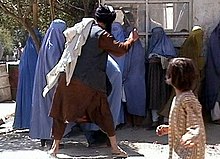Corrections
The examples and perspective in this article may not represent a worldwide view of the subject. (October 2011) |
| Criminology and penology |
|---|
 |


In criminal justice, particularly in North America, correction, corrections, and correctional, are umbrella terms describing a variety of functions typically carried out by government agencies, and involving the punishment, treatment, and supervision of persons who have been convicted of crimes.[1] These functions commonly include imprisonment, parole, and probation.[2] A typical correctional institution is a prison. A correctional system, also known as a penal system, thus refers to a network of agencies that administer a jurisdiction's prisons, and community-based programs like parole, and probation boards.[3] This system is part of the larger criminal justice system, which additionally includes police, prosecution and courts.[4] Jurisdictions throughout Canada and the US have ministries or departments, respectively, of corrections, correctional services, or similarly-named agencies.

"Corrections" is also the name of a field of academic study concerned with the theories, policies, and programs pertaining to the practice of corrections. Its object of study includes personnel training and management as well as the experiences of those on the other side of the fence — the unwilling subjects of the correctional process.[1] Stohr and colleagues (2008) write that "Earlier scholars were more honest, calling what we now call corrections by the name penology, which means the study of punishment for crime."[5]
Terminology
[edit]The idea of "corrective labor" (Russian: исправительные работы) in Soviet Russia dates back as far as December 1917.[6] From 1929 the USSR started using the terminology "corrective-labor camps" (Russian: исправительно-трудовые лагеря (ИТЛ))[7] and "corrective labor colonies" (Russian: исправительно-трудовые колонии (ИТК)).
The terminology change in US academia from "penology" to "corrections" occurred in the 1950s and 1960s which was driven by a new philosophy emphasizing rehabilitation. It was accompanied by concrete changes in some prisons, like giving more privileges to inmates, and attempting to instill a more communal atmosphere. At least nominally, most prisons became "correctional institutions", and guards became "correctional officers".[8] Although the corrections-related terminology continued thereafter in US correctional practice, the philosophical view on offenders' treatment took an opposite turn in the 1980s, when academics labeled the "get tough" program[which?] as "The New Penology".[9]
Community Based Corrections
[edit]
Community Based Corrections are sanctions imposed on convicted adults or adjudicated juveniles that occur in a residential or community setting outside of jail or prison. The sanctions are enforced by agencies or courts with legal authority over the adult or juvenile offenders.[10]
Community Based Corrections can focus on both of adults and juveniles, attempting to rehabilitate them back into the community. In contrary to the "tough on crime" mindset which expresses harsh punishment, this community based correctional method seeks to transition offenders back into the community.[11]
Sentences
[edit]In Canada, until 1972, the Criminal Code legislated that courts could impose a form of whipping on male offenders, to be administered on up to three occasions, but did not limit the number of strokes. Whipping of female offenders was not allowed. The whipping could be inflicted using a strap, cat-o'-nine-tails, or a paddle unless specified by the court.[12] The move to abolish corporal punishment in the Canadian penal system coincided with several reforms and a change from the Reform Institutions label to Corrections or Correctional.
Intermediate sanctions may include sentences to a halfway house or community service program, home confinement, and electronic monitoring. Additional sanctions may be financial and may include fines, forfeiture, and restitution; these are sometimes applied in combination.[13]
Theories
[edit]The use of sanctions, which can be either positive (rewarding) or negative (punishment) is the basis of all criminal theory, along with the main goals of social control, and deterrence of deviant behavior.
Many facilities operating in the United States adhere to particular correctional theories. Although often heavily modified, these theories determine the nature of the facilities' design and security operations. The two primary theories used today are the more traditional Remote Supervision[citation needed] and the more contemporary direct supervision model.[14] In the Remote Supervision Model, officers observe the inmate population from remote positions, e.g., towers or secure desk areas. The Direct Supervision Model positions prison officers within the inmate population, creating a more pronounced presence.
List of Departments of Corrections
[edit]United States
[edit]- Alabama Department of Corrections
- Alaska Department of Corrections
- Arizona Department of Corrections
- Arkansas Department of Correction
- California Department of Corrections and Rehabilitation
- Colorado Department of Corrections
- Connecticut Department of Correction
- Delaware Department of Correction
- District of Columbia Department of Corrections
- Florida Department of Corrections
- Georgia Department of Corrections
- Guam Department of Corrections
- Hawaii Department of Public Safety
- Idaho Department of Correction
- Illinois Department of Corrections
- Indiana Department of Correction
- Iowa Department of Corrections
- Kansas Department of Corrections
- Kentucky Department of Corrections
- Louisiana Department of Public Safety & Corrections
- Maine Department of Corrections
- Maryland Department of Public Safety and Correctional Services
- Massachusetts Department of Correction
- Michigan Department of Corrections
- Minnesota Department of Corrections
- Mississippi Department of Corrections
- Missouri Department of Corrections
- Montana Department of Corrections
- Nebraska Department of Correctional Services
- Nevada Department of Corrections
- New Hampshire Department of Corrections
- New Jersey Department of Corrections
- New Mexico Corrections Department
- New York State Department of Correctional Services
- North Carolina Department of Correction
- North Dakota Department of Corrections and Rehabilitation
- Ohio Department of Rehabilitation and Correction
- Oklahoma Department of Corrections
- Oregon Department of Corrections
- Pennsylvania Department of Corrections
- Puerto Rico Department of Corrections and Rehabilitation
- Rhode Island Department of Corrections
- South Carolina Department of Corrections
- South Dakota Department of Corrections
- Tennessee Department of Correction
- Texas Department of Criminal Justice (formed from the Texas Department of Corrections)
- Utah Department of Corrections
- Vermont Department of Corrections
- Virginia Department of Corrections
- Washington State Department of Corrections
- West Virginia Department of Corrections
- Wisconsin Department of Corrections
- Wyoming Department of Corrections
- Federal Bureau of Prisons
Other countries
[edit]See also
[edit]- American Correctional Association
- Death penalty
- Deterrence
- Individual rights
- National Commission on Correctional Health Care
- National Institute of Corrections
- National Law Enforcement and Corrections Technology Center
- National Prison Rape Elimination Commission
- Social control
- United States Bureau of Justice Statistics
Juvenile corrections
[edit]- Juvenile court
- Juvenile delinquency
- Juvenile Justice and Delinquency Prevention Act
- Office of Juvenile Justice and Delinquency Prevention
References
[edit]- ^ a b Mary Stohr; Anthony Walsh; Craig Hemmens (2008). Corrections: A Text/Reader. Sage. p. 1. ISBN 978-1-4129-3773-3.
- ^ Bryan A. Garner, editor, Black's Law Dictionary, 9th ed., West Group, 2009, ISBN 978-0-314-19949-2, OCLC 420487111 0-314-19949-7, p. 396 (or p. 424 depending on the volume[clarification needed])
- ^ Correctional system is defined as "a network of governmental agencies that administer a jurisdiction's prisons, and parole system" in Bryan A. Garner, editor, Black's Law Dictionary, 9th ed., West Group, 2009, ISBN 0-314-19949-7, p. 396, which does not define "penal system".
Blomberg and Lucken (2010) describe the post-1940 penal system in the United States of America as composed of "prisons, reformatories, parole, probation, juvenile courts [?], local jails, and a declining number of workhouses", and with added detail that "[h]owever the main focus of the system was on expanding and differentiating prisons, parole, and probation" in Thomas G. Blomberg; Karol Lucken (2010). American penology: a history of control. Transaction Publishers. p. 110. ISBN 978-0-202-36334-9.
Stohr et al., p. 1 distinguish prisons from community-based correctional programs like parole and probation. - ^ Michael Cavadino; James Dignan (2007). The Penal System: An Introduction. SAGE Publications. p. 1. ISBN 978-1-4129-2946-2.
- ^ Mary Stohr; Anthony Walsh; Craig Hemmens (2008). Corrections: A Text/Reader. Sage. p. 2. ISBN 978-1-4129-3773-3.
- ^
Beermann, R (1985). "Corrective labor". In Feldbrugge, F. J. Ferdinand Joseph Maria (ed.). Encyclopedia of Soviet Law. Law in Eastern Europe. Vol. 28 (Revised ed.). Brill. p. 200. ISBN 9789024730759. Retrieved 2016-05-06.
Corrective labor without deprivation of freedom [...] has developed from the initially ad hoc orders (some of them by Lenin himself) to apply it against class enemies. [...] The first legal enactments were issued as early as 19 December 1917 [...] Something new and constructive was brought into the stale and unimaginative air of correctional and penal practice [...].
- ^
Ivanova, Galina Mikhailovna (2015). "Chapter 1: Repression and Punishment". In Raleigh, Donald J (ed.). Labor Camp Socialism: The Gulag in the Soviet Totalitarian System. New Russian history. Routledge. p. 23. ISBN 9781317466642. Retrieved 2016-05-06.
On November 6, 1929, the Central Executive Committee and Sovnarkom of the USSR amended the 'Basic Principles of Criminal Legislation of the Union of SSR and the Union Republics' adopted in 1924. Article 13 of this document reads, in part: 'Social protection measures of a judicial-correctional nature are ... (b) deprivation of liberty in corrective-labor camps in remote locations of the USSR' [...] This was the first mention in Soviet legislation of the term 'corrective-labor camp' (ispravitel'no-trudovoi lager': ITL) [...]. [P]roclaimed principles of legality and humanism [...] are demonstrated by a different document - the Corrective-Labor Code of 1924.
- ^ John T. Whitehead; Mark Jones; Michael Braswell (2008). Exploring Corrections in America (2 ed.). Elsevier. p. 8. ISBN 978-1-59345-512-5.
- ^ John T. Whitehead; Mark Jones; Michael Braswell (2008). Exploring Corrections in America (2 ed.). Elsevier. pp. 8 and 54. ISBN 978-1-59345-512-5.
- ^ "Topic: Community Corrections - CrimeSolutions.gov". www.crimesolutions.gov.
- ^ McKenna, Brian; Skipworth, Jeremy; Pillai, Krishna (2017-01-26). "Mental health care and treatment in prisons: a new paradigm to support best practice". World Psychiatry. 16 (1): 3–4. doi:10.1002/wps.20395. ISSN 1723-8617. PMC 5269683. PMID 28127923.
- ^ Abolition of Corporal Punishment 1972, Correctional Service of Canada
- ^ Gail A. Caputo (2004). Intermediate sanctions in corrections. University of North Texas Press. p. 28. ISBN 978-1-57441-186-7.
- ^ Peter M. Carlson; Judith Simon Garrett (2008). Prison and Jail Administration: Practice and Theory. Jones & Bartlett Learning. pp. 46–47. ISBN 978-0-7637-2862-5.
Further reading
[edit]- Mary Stohr; Anthony Walsh; Craig Hemmens (2008). Corrections: A Text/Reader. Sage. ISBN 978-1-4129-3773-3.
- Todd R. Clear; George F. Cole; Michael D. Reisig (2010). American Corrections (9 ed.). Cengage Learning. ISBN 978-0-495-80748-3.
